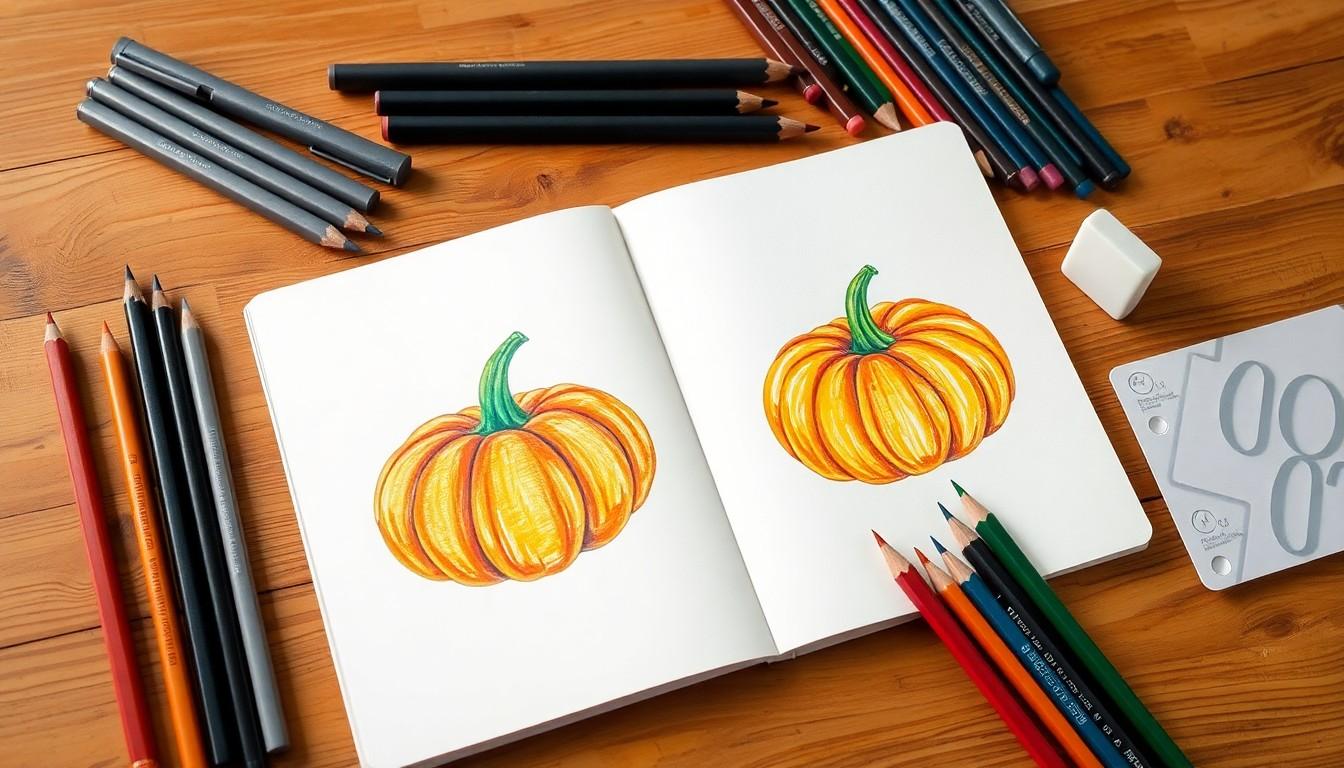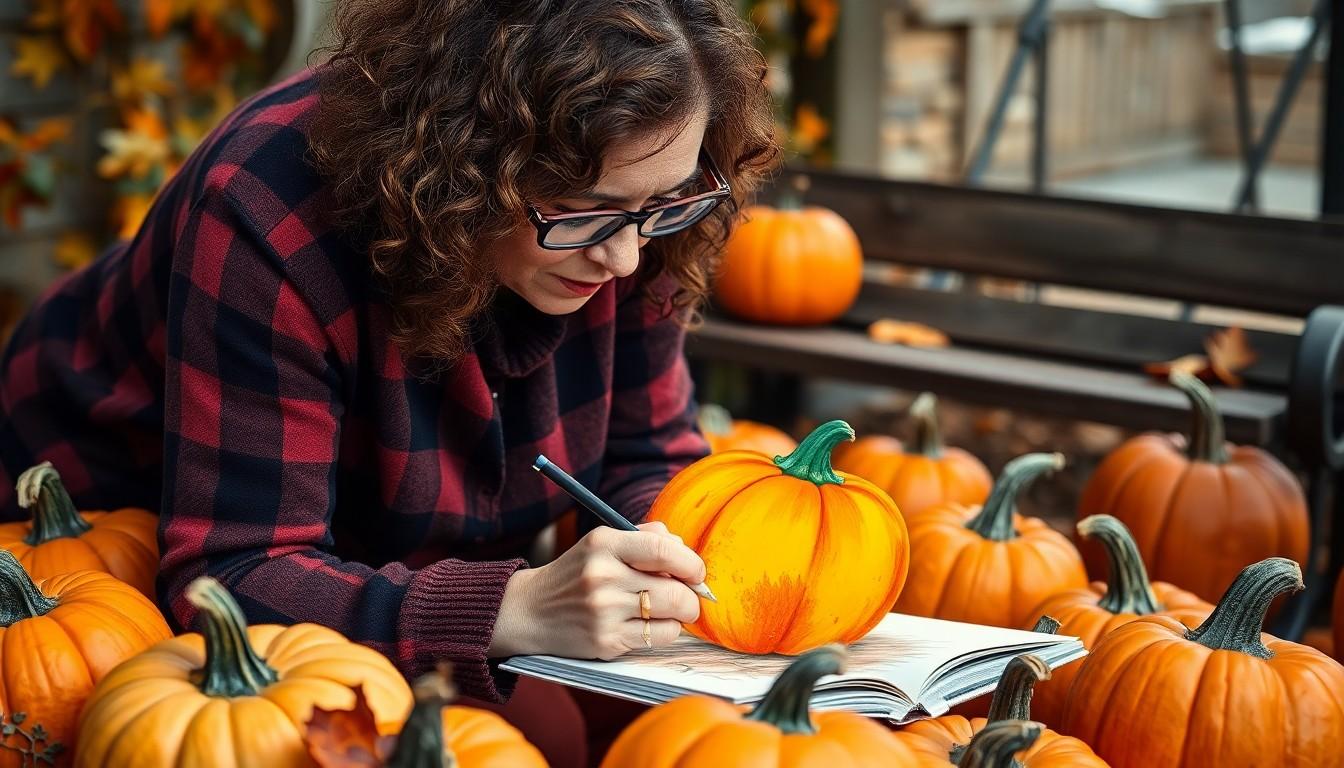As the leaves turn and the air gets crisp, visions of pumpkins dance in minds everywhere. Whether it’s for Halloween, Thanksgiving, or just to brighten up a gloomy day, drawing pumpkins can bring a splash of creativity into anyone’s life. But fear not, aspiring artists! You don’t need a degree in fine arts or a fancy studio to master the art of pumpkin drawing.
Pumpkin Drawing Simple
Pumpkin drawing serves as an enjoyable way to explore creativity during the fall season. Many artists, regardless of their experience level, find satisfaction in capturing the unique shape and color of pumpkins. Drawing entirely without prior training can yield impressive results when one embraces their imagination.
Various styles exist for pumpkin drawings, ranging from realistic representations to playful caricatures. Beginners often choose simple outlines, easing into more detailed work as confidence grows. Utilizing basic shapes for the initial sketch facilitates a clearer understanding of proportions and layouts.
Tools play a critical role in this creative process. Graphite pencils and colored markers frequently appear in initial sketches. Artists often add depth and texture with shading techniques, employing colors like orange, green, and yellow. Each color contributes to the overall vibrant depiction of pumpkins.
Inspiration for pumpkin drawings can arise from various sources. Still-life arrangements, photographs, and seasonal decorations serve as excellent references. Many find that observing real pumpkins, especially in patches, provides rich detail that enhances their artwork.
Sharing pumpkin drawings within communities fosters a sense of connection. Engaging with others can lead to valuable feedback and new ideas. Participating in local art events or online forums can cultivate a sense of camaraderie and growth.
Overall, pumpkin drawing remains a rewarding activity that encourages both self-expression and artistic exploration. With a few simple tools and a willingness to learn, anyone can enjoy this vibrant and seasonal art form.
Materials Needed for Simple Pumpkin Drawing

Drawing pumpkins requires a few essential materials. These tools enhance the creative process and yield satisfying results for artists at various skill levels.
Drawing Tools
Graphite pencils serve as a fundamental tool, allowing artists to sketch outlines easily. Fine-tip markers offer precision and clean lines for detailing. Charcoal can enrich shading and add depth to the drawing. An eraser aids in correcting mistakes, ensuring a polished appearance. Rulers help maintain symmetry, particularly for simple geometric shapes. Sketchbooks or printer paper provide a surface to practice and refine skills. Selecting quality materials contributes to a better overall outcome.
Color Options
Orange is the primary color for pumpkins, but shades of yellow and green also enhance the drawing’s vibrancy. Brown adds realism to the stems, while lighter hues can depict highlights. Using white for light reflections creates a three-dimensional effect. Additionally, leaving some areas uncolored establishes a contrast, lifting the artwork. Colored pencils and markers allow for blending and layering different shades. Experimenting with various colors encourages creativity and personal expression in artwork.
Step-by-Step Guide to Pumpkin Drawing
Drawing pumpkins involves a straightforward process. Following these steps leads to an enjoyable experience for artists at any skill level.
Basic Shapes
Start by sketching a circle for the main body of the pumpkin. Add an oval shape on top for the stem. Positioning these basic shapes forms the foundation of the drawing. Each pumpkin has unique curves; modifying the circle and oval creates variety. Use light lines to adjust proportions easily. Artists can make the pumpkin wider or taller depending on the desired look. Keep this stage simple to establish a strong base for the next details.
Adding Details
After establishing basic shapes, refine the design by adding texture. Draw horizontal and vertical lines across the pumpkin to represent its ridges. These lines create depth and realism. A flick of the wrist can outline the stem, giving it a natural look. Add small curves to suggest imperfections or variations in shape. Shading around the edges enhances the illusion of roundness. Use a variety of colors, including orange, yellow, and light green, to bring life to the drawing. Applying these techniques results in a vibrant and eye-catching pumpkin illustration.
Tips for Enhancing Your Pumpkin Drawing
To elevate pumpkin drawings, several techniques and creative approaches can be applied. These methods help in achieving more depth and individuality in each artwork.
Shading Techniques
Effective shading techniques enhance realism in pumpkin drawings. Artists should consider using a gradient effect to simulate natural light. Applying darker tones near the base and lighter shades toward the top creates a three-dimensional look. Blending techniques, like using a blending stump or finger, soften transitions between colors. Additionally, utilizing cross-hatching adds texture around the ridges, giving a more dynamic appearance. Experimenting with pressure applied to the pencil can create varied shading effects, further adding depth to the pumpkin’s surface while emphasizing its contours.
Creative Variations
Incorporating creative variations makes pumpkin drawings unique and engaging. Artists can explore abstract designs, such as using geometric shapes or patterns, to reimagine the classic pumpkin form. Adding whimsical features like exaggerated eyes and unusual expressions results in playful characters. Experimenting with different backgrounds, such as fall scenery or nighttime settings, enhances the overall impact. Using unconventional colors, like blues and purples, opens new artistic avenues while highlighting the pumpkin’s shape. Each variation offers a chance to express individuality and creativity, making the drawing process enjoyable and fulfilling.
Pumpkin drawing offers a delightful way to engage with creativity during the fall season. Whether for Halloween or Thanksgiving, it invites artists of all skill levels to explore their artistic potential. With simple techniques and basic materials, anyone can create captivating pumpkin illustrations.
The process not only nurtures individual expression but also fosters community connections through sharing and feedback. By experimenting with shapes colors and styles, artists can develop their unique flair while enjoying the satisfying journey of bringing pumpkins to life on paper. Embracing this creative activity can lead to a rewarding experience that celebrates the beauty of autumn.




